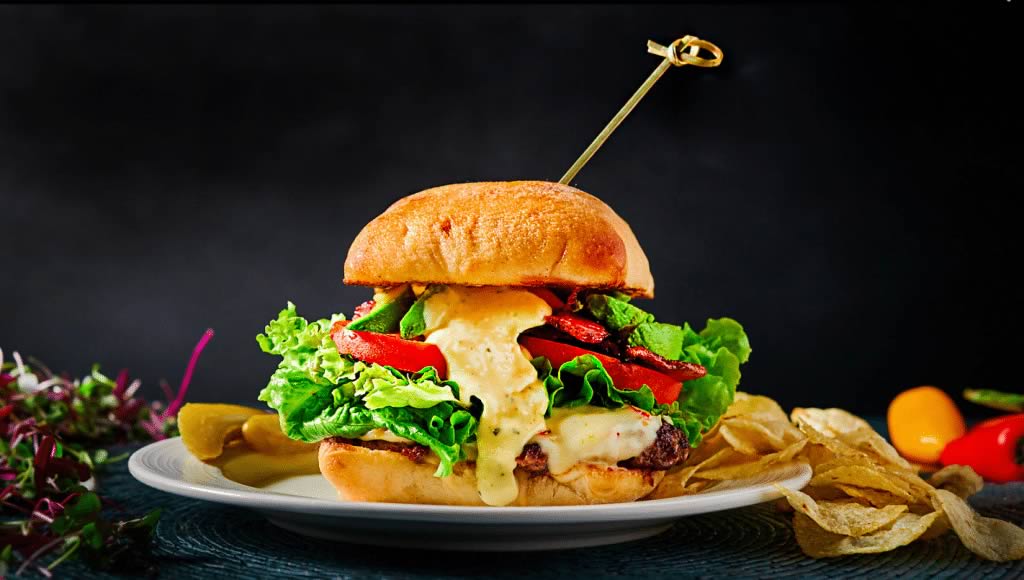
Veggie burgers originated in England in 1982 as a plant-based ‘hamburger’ option for people who preferred a vegetarian eating style. That first product was sold as a dry mix; simply add water, form it into a patty, and cook. Gardenburger released the first commercial veggie burger in 1992 and in 1993 Boca Burger produced their first products. These original veggie burgers didn’t claim to taste like hamburgers; they were simply a non-meat option usually made from legumes, vegetables, and soy.
Fast forward to today with two plant-based burgers that are designed to taste like meat. The Impossible Burger and Beyond Burger are non-meat burgers that are marketed both as a vegetarian burger option as well as a way for responsible consumers to protect the climate. But are they healthier than hamburgers?
Beyond Burger
The Beyond Burger was developed in 2014 and updated in 2016. It relies on pea, mung bean, and rice proteins to provide a meaty taste and texture. Coconut oil and cocoa butter simulate the marbling found in hamburger to create a juicy texture similar to the fat in hamburger. Beets provide the red color we expect in a burger. The company’s goal is to use plants instead of animal products to make a burger with similar nutrients found in animal burgers and address four global issues: human health, climate change, constraints on natural resources, and animal welfare.
Impossible Burger
Impossible Burgers also use a variety of plant products to produce their burgers, with some differences. The protein comes from soy and potato, the fat from coconut and sunflower oil, and methylcellulose and food starch hold it all together. Impossible Burgers contain one additional ingredient: heme. Heme is a molecule found in both plants and animals and is an essential component of iron that carries oxygen in the blood from the lungs to all parts of the body. The scientists at Impossible Foods determined that heme is the component that provides the taste we expect in red meat. While heme is also found in plants, Impossible Foods decided to make their own heme by genetically engineering yeast with the gene for soy leghemoglobin (the type of heme naturally found in soy foods) and then adding the heme from the yeast to the Impossible Burger ingredients.
Because the heme in Impossible Burgers is genetically engineered, the back of the package has a circular symbol that says ‘bioengineered’, in compliance with the National Bioengineered Food Disclosure Law passed by Congress in July 2016 that establishes a national mandatory standard for disclosing bioengineered foods. The Impossible Burger contains two bioengineered ingredients: soy leghemoglobin and soy protein.
You can find symbols for bioengineered foods here.
Nutrition Comparison:
The Harvard Health Blog put together a comparison chart of the calories and nutrients in a single serving of different types of burgers.
| Calories | Fat (g) | Sat Fat (g) | Chol (mg) | Sodium (mg) | Carb (g) | Fiber (g) | Protein (g) | |
| Impossible Burger (4 oz) | 240 | 14 | 8 | 0 | 370 | 9 | 3 | 19 |
| Beyond Burger (4 oz) | 250 | 18 | 6 | 0 | 390 | 3 | 2 | 20 |
| 85% lean ground beef (4 oz) | 240 | 17 | 6 | 80 | 80 | 0 | 0 | 21 |
| Ground turkey (4 oz) | 170 | 9 | 2 | 80 | 70 | 0 | 0 | 22 |
| Black Bean Burger (Sunshine Brand, 2.7 oz) | 260 | 16 | 1.5 | 0 | 190 | 8 | 8 | 10 |
Important points to note:
- Impossible Burgers and Beyond Burgers contain similar amounts of calories, protein, total fat, and saturated fat as 85% lean ground beef burgers.
- The Impossible Burger and Beyond Burger contain over 4 times as much sodium as the 85% lean ground beef; a significant difference if you’re reducing sodium for healthy blood pressure reasons. If you’re choosing one of these plant-based burgers instead of a lean ground beef burger to improve your cardiovascular health or for weight loss, think again.
- On the positive side, Impossible Burgers and Beyond Burgers contain small amounts of fiber and no cholesterol. This balance can help promote a healthy cardiovascular system.
- Because they’re made from plants, both Impossible Burgers and Beyond Burgers contain some carbohydrate, but not as much as a traditional veggie burger made from legumes. The legume-based veggie burger, however, contains 3 times as much fiber.
- If health is your primary reason for choosing a burger, opt for a ground turkey burger. It contains fewer calories, less fat, and saturated fat to protect your heart and help with weight loss.
- B12 is an essential vitamin for optimum health that is naturally found only in animal products. Impossible Burgers contain added B12, which is important for people who do not eat any type of animal foods such as milk, cheese, yogurt, eggs, chicken, fish or meat.
Choosing more foods from plants is part of an overall healthy diet, but so is eating fewer processed foods. Both the Impossible Burger and the Beyond Burger are highly processed, and the Impossible Burger also contains bioengineered heme.
If your primary goal is to protect animals and help preserve the planet, choose a standard veggie burger made from legumes. You’ll get the fiber and nutrients found in plants without lots of processing.
If your primary goal is to choose the burger that is best for your health, choose a ground turkey burger or a standard veggie burger. You’ll enjoy a burger that is low in harmful saturated fat and sodium.
If your primary goal is to eat a plant-based burger that actually tastes like a hamburger, choose either the Impossible Burger or the Beyond Burger.
By Lynn Grieger, RDN, CDE, CPT, CHWC
References:
- Smithsonian.com The History of the Veggie Burger. K. Annabelle Smith. https://www.smithsonianmag.com/arts-culture/history-veggie-burger-180950163/ published 3-19-14. Accessed 10-27-19.
- Beyond Meat. https://www.beyondmeat.com/products/the-beyond-burger/ Accessed 10-27-19
- Impossible Food. https://impossiblefoods.com/food/ Accessed 10-27-19
- U.S. Food and Drug Administration. FDA Authorizes Soy Leghemoglobin as a Color Additive. https://www.fda.gov/food/cfsan-constituent-updates/fda-authorizes-soy-leghemoglobin-color-additive published 7-31-19. Accessed 10-28-19
- Impossible Food. FAQ: How do you make heme? https://faq.impossiblefoods.com/hc/en-us/articles/360034767354 accessed 10-28-19
- Harvard Health Publishing. Harvard Health Blog. Impossible and beyond: How healthy are these meatless burgers? Emily Gelsomin. https://www.health.harvard.edu/blog/impossible-and-beyond-how-healthy-are-these-meatless-burgers-2019081517448 published 8-15-19. Accessed 10-28-19
© Food and Health Communications
Woodholme encourages a healthy diet and proper nutrition as one aspect of maintaining heart health. The nutrition information and recipes are presented for informational purposes only and are not intended to take the place of one-on-one advice from your doctor. Please follow your personal physician’s recommendations if any recipes, ingredients, or advice found here conflict with what your doctor has told you.

